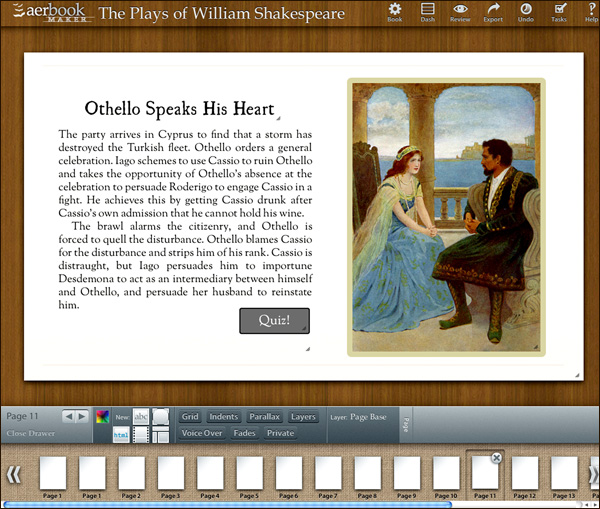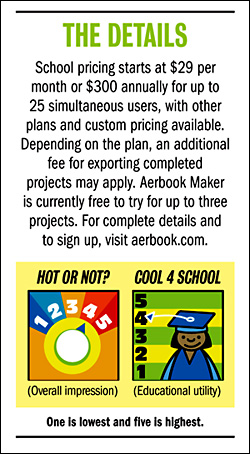I’ve spent the past few months reporting on platforms that help school librarians make ebooks available to their patrons. But what about librarians and other educators who want to go beyond a read-only experience and enable their students to easily create, share—and even market—their very own slick, tablet-ready graphical ebooks and mobile apps? Enter Aerbook Maker.

To create an ebook or app in Aerbook Maker, start in the users’ dashboard, where you can upload an imprint logo. Next, set the project’s dimensions and orientation from a drop-down menu that makes selection easy with presets currently available for Kindle Fire, iPad, iPhone, iPhone retina display, and Instabook for Instagram. Alternatively, a user can create a project in any custom dimensions they choose. A cover can be added as well as titles and author names. Blank projects start out with a single page in the editor and authors can add images, text, video or audio, repositioning and resizing items and tweaking designs on the fly, with all project changes saved to the cloud. Pages can be saved as templates, too, making it easy to reuse page layouts—a feature that school librarians and teachers could tap into to make it easier for younger students to create picture books.
 More sophisticated students can add depth, motion, and interactivity to their ebooks by adding “behaviors”—actions that happen when readers click on them—to any project element. Behaviors include internal links for jumping—hypercard-style—to another page within the book or external links for opening Web pages; playing an audio or video file; or revealing or hiding a page layer. Authors can also add parallax animation, a simple technique that simulates depth by making page elements move at assigned speeds, depending on how “far” they are designated to be from the viewer.
More sophisticated students can add depth, motion, and interactivity to their ebooks by adding “behaviors”—actions that happen when readers click on them—to any project element. Behaviors include internal links for jumping—hypercard-style—to another page within the book or external links for opening Web pages; playing an audio or video file; or revealing or hiding a page layer. Authors can also add parallax animation, a simple technique that simulates depth by making page elements move at assigned speeds, depending on how “far” they are designated to be from the viewer.
Authors can also elect to share parts of their books on the Web and across social networks for feedback and collaboration, another advantage of cloud-based creation. Once a version of an ebook is deemed complete, you can export it as a downloadable file that can be made available for free or for sale on a private website, or submitted to Amazon or Apple. Soon, Aerbook promises to offer a direct channel for selling DRM-free iBooks directly to customers, all from the Aerbook dashboard.
Still brand new, Aerbook Maker is already pretty cool stuff. I was able to create a basic ebook and export it in a couple of different file formats within an hour. Creating apps is undeniably trickier: they’re exported in Corona format, which requires developers to have a copy of the free Corona SDK to view it in a simulator and build it for distribution. While that may sound daunting, it’s worth remembering that an eighth grader created Bubble Ball, one of the most popular iPhone apps ever, so we might think twice before selling our students short. Plus, Aerbook promises to further streamline and simplify app development, too, eventually offering a complete Web-based app-building and distribution service.
Since many of us still have a couple weeks left before school resumes, the time to sign up for a free account and experiment with Aerbook is now. If you have any ideas about unique ways to use the product in education, or if you’d like to try piloting Aerbook Maker in your school, you’re invited to contact the company at aerbookmaker@aerbook.com.


